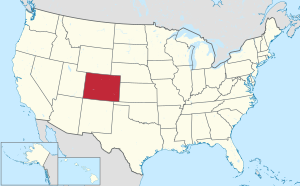Dolores County, Colorado
Dolores County | |
|---|---|
 Location within the U.S. state of Colorado | |
 Colorado's location within the U.S. | |
| Coordinates: 37°45′N 108°31′W / 37.75°N 108.52°W | |
| Country | |
| State | |
| Founded | February 19, 1881 |
| Named for | Dolores River |
| Seat | Dove Creek |
| Population (2000) | |
| • Total | 1,844 |
| Time zone | UTC−7 (Mountain) |
| • Summer (DST) | UTC−6 (MDT) |
| Website | www |
Dolores County is the seventh least populous of the 64 counties of the State of Colorado of the United States. The county population was 1,844 at U.S. Census 2000.[1] The county seat is Dove Creek.
History
Dolores County as well as much of southwestern Colorado is rich in Indian ruins and sites of the Anasazi. It is thought that the area has been the site of human habitation since at least 2500 B.C. According to the Heritage Center, Dolores County contains at least 816 recorded archaeological sites as of 1989. Also, the county contains a site of regional historic interest, the Dominguez-Escalante Trail of 1776. The trail marks a historic 1800-mile trip intended to discover an overland route between Santa Fe, New Mexico and Monterey, California.[2]
Dolores County was created by the Colorado legislature on February 19, 1881 out of the western portions of Ouray County. It was named for the Dolores River. The complete Spanish name was Rio de Nuestro Senora de los Dolores (River of our Lady of Sorrows), as reported by Father Silvestre Vélez de Escalante in 1776.[3] Originally set in Rico, the county seat was moved to Dove Creek in 1941.
Geography
According to the U.S. Census Bureau, the county has a total area of 2,766 km² (1,068 mi²). 2,763 km² (1,067 mi²) of it is land and 3 km² (1 mi²) of it is water. The total area is 0.11% water.
Dolores County, like other counties in Colorado along its border with Utah, is split into two geographically distinct regions, and in fact, under normal travel conditions, it is necessary to leave the county to travel between the two regions. The western portion of the County along the Utah border is relatively low (6500-7500 feet in elevation) and flat, and consists of irrigated and dryland farming areas. It is especially well-known for the growing of various varieties of beans, including pinto beans and many variety of old Anasazi beans. The eastern portion of the County is located in the highest peaks of the San Juan Mountains, around the old mining and modern tourist town of Rico, and except for cattle grazing in the San Juan National Forest, has virtually no agriculture, in part because its elevations range from 9,000 to 14,000+. Rico is developing in many ways as a bedroom community for the much wealthier town of Telluride in San Miguel County to the north.
Adjacent Counties
- San Miguel County, Colorado - north
- San Juan County, Colorado - east
- Montezuma County, Colorado - south
- San Juan County, Utah - west
Demographics
As of the census2 of 2000, there were 1,844 people, 785 households, and 541 families residing in the county. The population density was 1/km² (2/mi²). There were 1,193 housing units at an average density of 0/km² (1/mi²). The racial makeup of the county was 95.28% White, 0.05% Black or African American, 1.95% Native American, 0.38% Asian, 0.05% Pacific Islander, 0.60% from other races, and 1.68% from two or more races. 3.85% of the population were Hispanic or Latino of any race.
There were 785 households out of which 24.50% had children under the age of 18 living with them, 57.70% were married couples living together, 8.50% had a female householder with no husband present, and 31.00% were non-families. 26.20% of all households were made up of individuals and 10.40% had someone living alone who was 65 years of age or older. The average household size was 2.35 and the average family size was 2.82.
In the county the population was spread out with 21.90% under the age of 18, 6.80% from 18 to 24, 26.30% from 25 to 44, 27.80% from 45 to 64, and 17.10% who were 65 years of age or older. The median age was 42 years. For every 100 females there were 107.20 males. For every 100 females age 18 and over, there were 104.50 males.
The median income for a household in the county was $32,196, and the median income for a family was $38,000. Males had a median income of $30,972 versus $20,385 for females. The per capita income for the county was $17,106. About 10.20% of families and 13.10% of the population were below the poverty line, including 9.80% of those under age 18 and 18.30% of those age 65 or over.
Cities and towns
National monument
National forest and wilderness
National trails
Bicycle routes
Scenic byway
See also
External links
References
- ^ "Annual County Population Estimates and Estimated Components of Change: April 1, 2000 to July 1, 2006 (CO-EST2006-alldata)" (CSV). 2006 Population Estimates. United States Census Bureau, Population Division. 2007-03-22. Retrieved 2007-05-17.
{{cite web}}: Check date values in:|date=(help) - ^ Katieri Treimer, Site research report, site no. 916, Southwest Colorado, Earth Metrics Inc. and SRI International for Contel Systems and the U.S. Air Force 1989
- ^ Colorado State Archives
